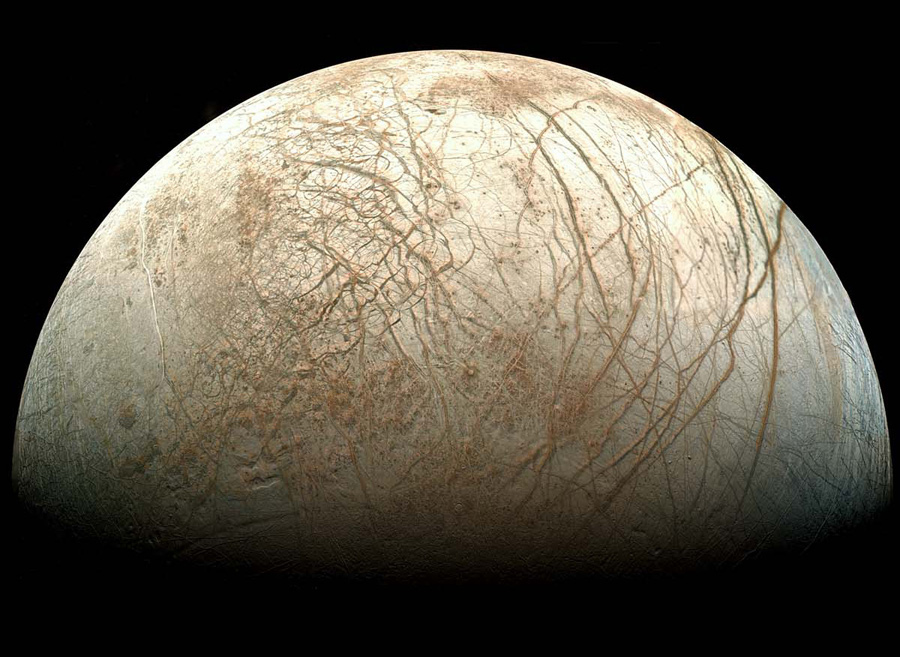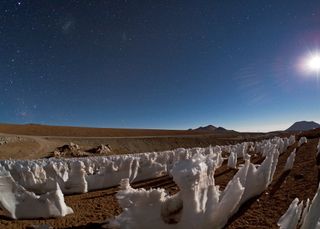Jupiter's Moon Europa May Have 'Spikes of Ice'

THE WOODLANDS, Texas — The equator of Jupiter's icy moon Europa may be covered with huge spikes of ice, scientists say.
Astronomers have known for some time that Jupiter's moon Europa is icy, and now scientists are trying to understand just what form that ice takes by using some of the coldest places on Earth as analogues. Huge ice spikes, known as penitents, found on Earth could form on Europa, they said.
"It's a pretty obscure geological feature on the Earth," Dan Hobley, an astronomer at the University of Virginia, told SPACE.com after he presented his findings at the 44th annual Lunar and Planetary Science Conference.
The 3.3 to 16.4 foot (1 to 5 meter) spikes of ice only grow in certain parts of the Andes mountains on Earth, but those areas of the world serve as good proxies for what Europa's geology might be like, Hobley said. [Photos of Europa, Jupiter's Mysterious Icy Moon]
It takes a very specific set of circumstances for penitentes to form, Hobley said. The angle of the sun has to hit the ice in just the right way to keep the spikes of ice standing on end and buried deep into the ground. The blades grow in very dry conditions and can thrive in dirt-filled or clean circumstances.
As far as scientists can tell right now, all of those environments exist along Europa's equator, Hobley said.

Although Europa has been observed using radar and spectroscopy, scientists have not been able to understand exactly what the surface of this moon looks like. The geological features of Europa seem "basically random," Hobley said, but the existence of penitentes could offer an explanation.
Get the Space.com Newsletter
Breaking space news, the latest updates on rocket launches, skywatching events and more!
Scientists have found that Europa's equator is warmer than it should be, and penitentes could explain that mysterious temperature, Hobley said. The ice spines reflect heat onto one another, creating a warmer area because the sunlight gets trapped bouncing from ice spike to ice spike, Hobley explained.
The scientist and his colleagues are interested in understanding what the surface of Europa looks like, partially because it's a first step towards designing a viable lander that could safely touch down on the moon's frozen surface.
But it might not be that simple, Hobley said.
The icy shell of Europa's surface might shift occasionally, displacing the area of the alien world that used to be its equator. Penitentes don't naturally form in higher latitudes, so if the shell does shift, that could create a problem for astronomers trying to map exactly where to set down a lander.
"We're at the state where this is a good, solid guess," Hobley said.
Follow Miriam Kramer @mirikramer and Google+. Follow us @Spacedotcom, Facebook and Google+. Original article on SPACE.com.
Join our Space Forums to keep talking space on the latest missions, night sky and more! And if you have a news tip, correction or comment, let us know at: community@space.com.

Miriam Kramer joined Space.com as a Staff Writer in December 2012. Since then, she has floated in weightlessness on a zero-gravity flight, felt the pull of 4-Gs in a trainer aircraft and watched rockets soar into space from Florida and Virginia. She also served as Space.com's lead space entertainment reporter, and enjoys all aspects of space news, astronomy and commercial spaceflight. Miriam has also presented space stories during live interviews with Fox News and other TV and radio outlets. She originally hails from Knoxville, Tennessee where she and her family would take trips to dark spots on the outskirts of town to watch meteor showers every year. She loves to travel and one day hopes to see the northern lights in person. Miriam is currently a space reporter with Axios, writing the Axios Space newsletter. You can follow Miriam on Twitter.
Most Popular

